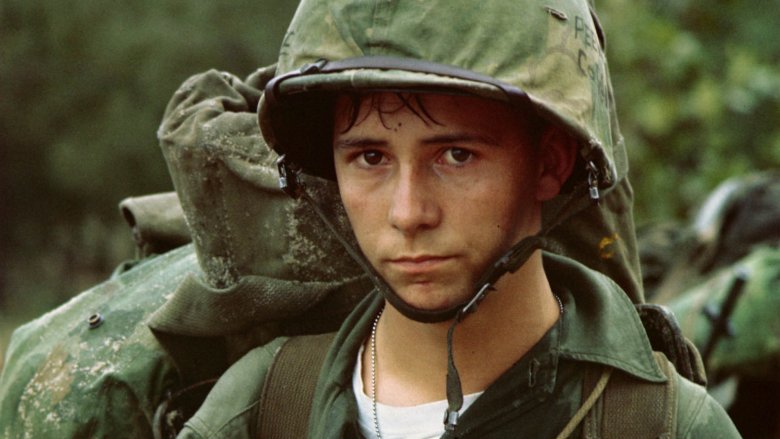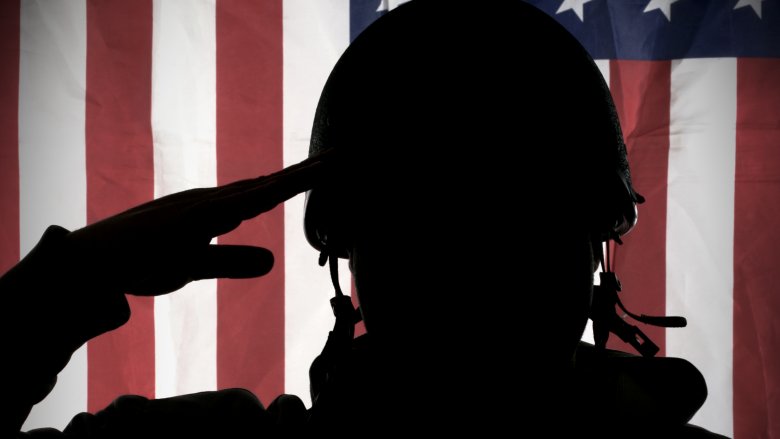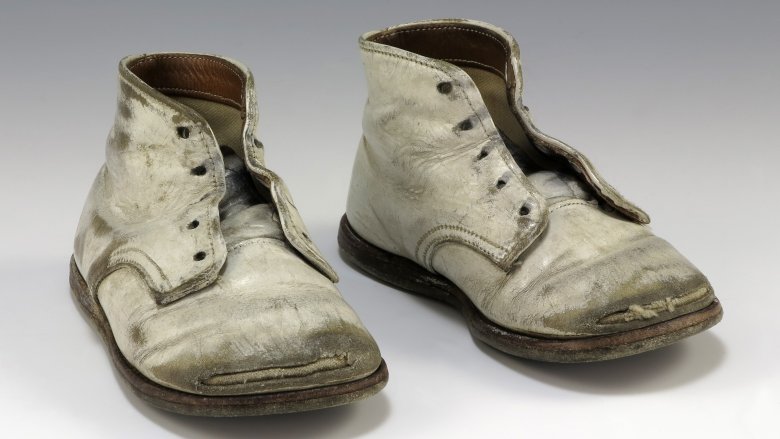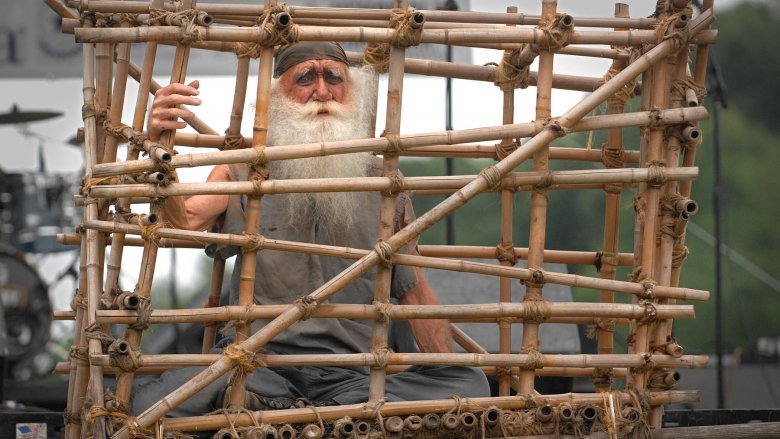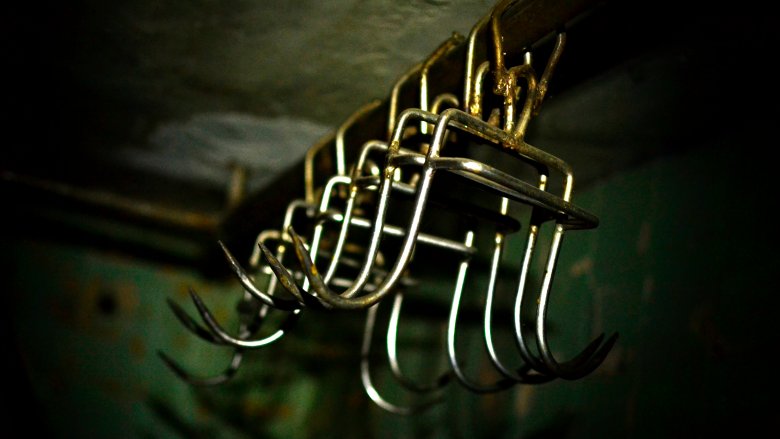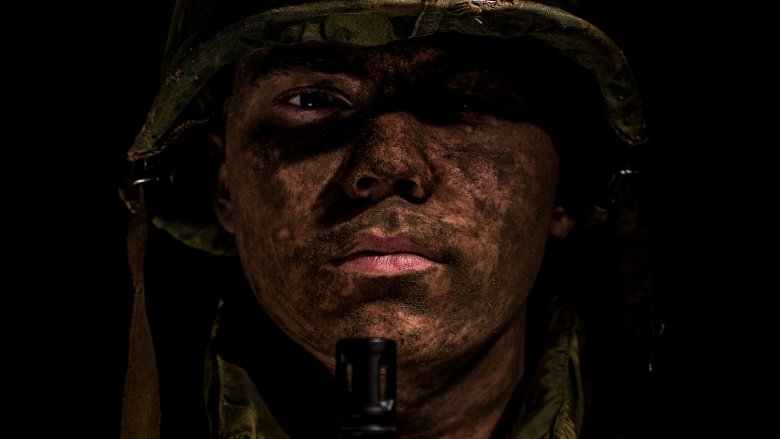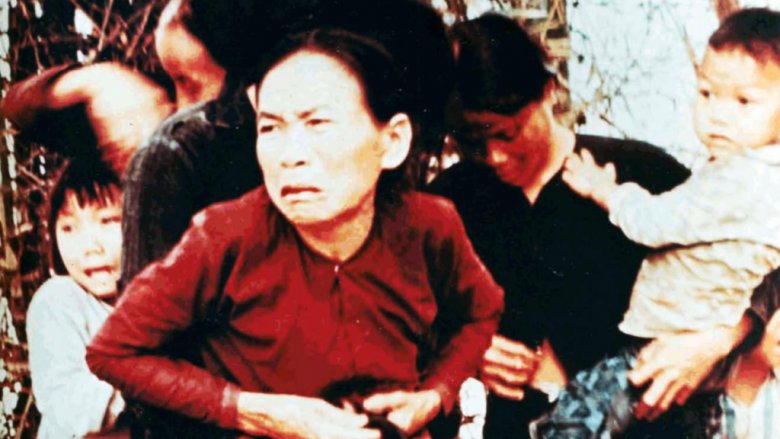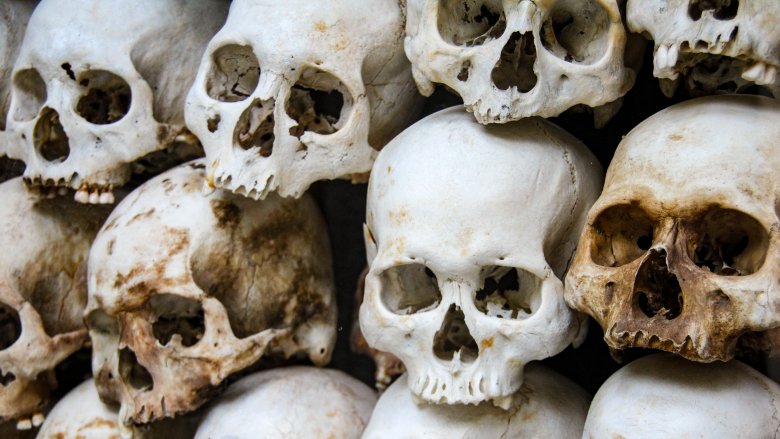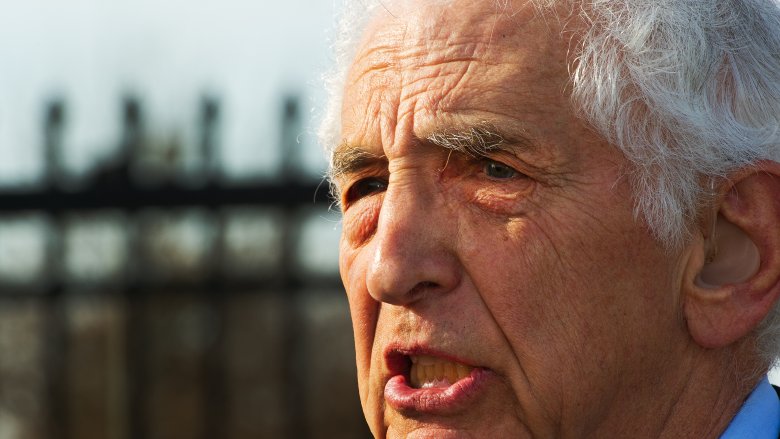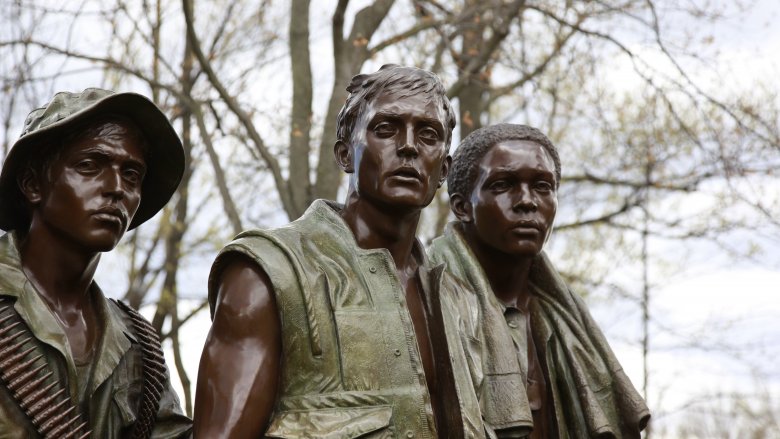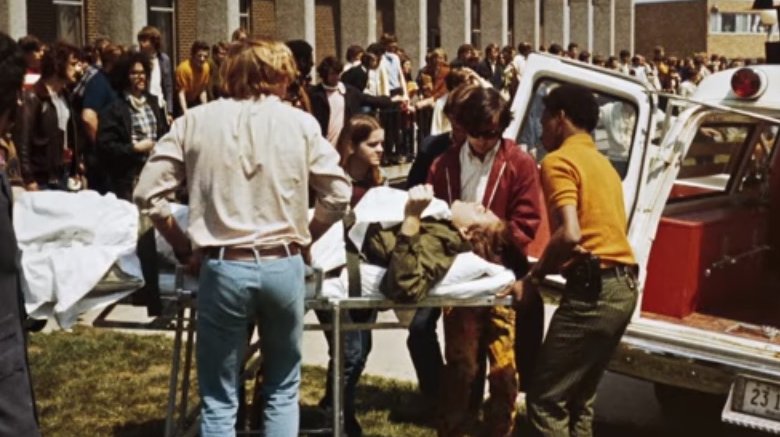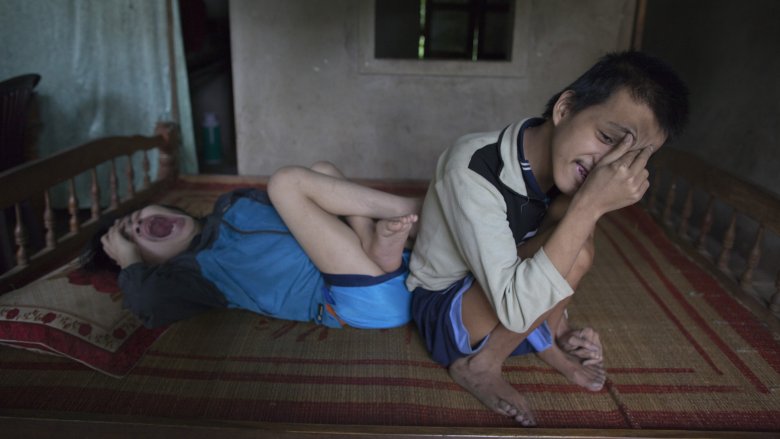Messed Up Things From The Vietnam War
War: What is it good for? Edwin Starr would say "absolutely nothing." In 1964 President Lyndon Johnson seemingly agreed, telling his national security adviser that the Vietnam War wasn't "worth fighting for." Nevertheless, he immersed America in the "biggest damn mess" he ever saw.
Per History, World War II bred bedlam in Vietnam when Japan wrested the country from French colonizers. In 1945 a French-backed Vietnamese emperor gained power, and Communist honcho Ho Chi Minh mounted an uprising that gave rise to North Vietnam via the First Indochina War. This bloodshed bled into the Vietnam War.
The war had gore galore and rage to spare as napalm and incendiary policies scorched physical and political landscapes. South Vietnamese leader Ngo Dinh Diem and JFK were shot dead three weeks apart in 1963. In August 1965, America had its "first major battle" in Vietnam, and domestic discontent over racial discrimination exploded during the Watts Riots. In 1968 the bloodiest phase of the war began, and Martin Luther King and Robert Kennedy were killed. As Americans were rocked by tectonic social shifts, the war's many faults shook their collective conscience. And as the Vietnam War's countless cruelties came to light, many came to see it as a tragic travesty.
The U.S. declared POWs dead to bury a secret operation
In 1964, Uncle Sam unleashed the dogs of war after North Vietnam allegedly attacked American vessels in the Gulf of Tonkin. The U.S. government insisted it didn't instigate the incident, which didn't really happen as described. In reality, commandos had raided nearby North Vietnamese targets as part of an operation originated by the CIA. Per the Associated Press, in 1959 the CIA began recruiting South Vietnamese men for espionage and sabotage efforts. Frequently hired out of high school, the commandos were promised $2,000 annually plus $100 monthly to their families.
The operation ran like a legless racehorse. Every commando that entered North Vietnam got captured or killed. By 1965 the U.S. military had taken charge and started telling the relatives of captive commandos that their loved ones died in the line of duty. However, hundreds had actually survived. Ex-intelligence analyst Sedgwick Tourison explained that the military wanted to save money. Declaring the POWs deceased allowed the military to stop monthly payments to the deceived and grieving families. Moreover, the mission had been a humiliating failure, and officials worried the commandos were undercover Communists.
The commandos were actually under duress. They withstood years (sometimes decades) of torture. After the war, 281 survivors sought payment, but their service was no longer officially acknowledged. After months of media coverage, in 1996 the government begrudgingly confirmed the cover-up. Despite pushback from the Pentagon, the commandos eventually won a court battle for back pay.
War-born orphans were dumped in trashcans
Many GIs in Vietnam made love and rape and war, creating embattled children. Often the offspring of white or black men and Vietnamese women, these babies resembled blended enemies. Their blue eyes made numerous Vietnamese see red, and their curly hair became a curse. As Smithsonian Magazine described, many of their mothers didn't view them as tiny humans but humongous burdens. They treated their children like literal trash, dumping them in trashcans and at orphanage entrances.
Society also regarded the kids as garbage. The Vietnamese dubbed them "children of the dust." They became vagabonds and beggars. Even those who were adopted were sometimes given away by their new parents. Peers picked on them for being poor and parentless. One former bully recalled that the forlorn orphans "would just look down and walk away." Many wished to walk away from Vietnam altogether and find their American fathers.
Like a deadbeat dad, the U.S. refused to pay attention to the children's pain. In 1970 the Defense Department defended its stance, stating that orphans' wellbeing "has never been and is not now considered an area of government responsibility." That tune changed in 1975. As North Vietnamese troops prepared to topple Saigon, rumors circulated that the incoming Communists would slaughter anyone connected to America. President Gerald Ford green-lit Operation Babylift, which evacuated 2,547 orphans via airlift. The first official flight crashed, killing 138 people, 78 of whom were children.
'Tiger cages' became torture chambers
War is organized barbarism on an enormous scale. Yet people tend to accept it more than less frequent instances of torture. As Dr. Darius Rejali observed, torture "gives one person absolute power over another," which distorts the torturer's morals and worsens societies that condone it. While war takes a greater material toll, torture nurtures and conveys inhumanity. Perhaps that's why South Vietnam and America remained mum about placing people in tiger cages.
A former prisoner compared them to coffins. Constructed by French colonists in 1940, tiger cages were designed to hold POWs, per Atlas Obscura. But South Vietnam used them to detain anyone deemed "politically dangerous," including civilians with "anti-Government" leanings. The New York Times described the original cages as "small concrete trenches with bars on top" which tightly packed five to seven people. Newer units provided by the United States contained a single inmate. North Vietnam, meanwhile, had its own incarnation of tiger cages, claustrophobic bamboo enclosures (above) used to torture trapped troops.
Guards starved detainees and hit them with sticks. One prisoner remembered being force-fed soapy water and receiving electric shocks. A pair of sisters arrested for attempting to aid Communists spent seven years in tiger cages, where they were burned with quicklime. It's estimated that South Vietnam kept 20,000 to 200,000 prisoners in tiger cages, sometimes for years without trial. The practice came to light after two U.S. Congressmen visited South Vietnam in 1970 and reported the horrors they witnessed.
Men were hung from meat hooks
It's hard to quantify the harm caused by combat exposure and torture because, as the Lancet noted, soldiers tend to be healthier than the average person. Even so, the U.S. Department of Veterans Affairs found that Vietnam veterans "with high exposure to warzone stress were nearly twice as likely to have died" between 1987 and 2013 than those who experienced less stress. Some struggled with PTSD and substance abuse 40 years after coming home, not to mention increased the back, joint, and neurological problems.
Arizona Senator John McCain was never physically the same after surviving over five years as a POW. Per ABC, in 1967 McCain's plane was struck by a missile, forcing him to eject. In the process, he broke both arms and a leg. Then his captors wrecked his right shoulder before bayoneting him. They later performed a shoddy surgery on his leg, leaving him with a limp. To force a false confession, guards beat him "every two or three hours" for four days. McCain became incapable of lifting his arms above his shoulders.
Future Congressman Sam Johnson suffered seven years in captivity. He spent 42 months in solitary confinement, his legs confined by stocks or shackles while he laid on a cement bed. Other POWs endured having all four limbs bound together (sometimes behind their backs), whereupon they were hung from meat hooks for hours or days.
The Tiger Force wore human ears around their necks
Reflecting on what he witnessed in Vietnam, platoon medic Larry Cottingham remarked, "There was a period when just about everyone had a necklace of ears." Cottingham served as part of the Tiger Force, a unit assembled in 1966 to "out-guerrilla" the Vietcong, per the Pittsburgh Post-Gazette. Initially hailed as heroes, the Tiger Force soon saw killing as "the way to live," according to one Tiger.
In 1967 the jaded GIs executed untold numbers of defenseless villagers. As a former member recounted, "We weren't even keeping count. I knew it was wrong, but it was an acceptable practice." Not everyone found it acceptable, though. Tiger Force member Gerald Bruner threatened to shoot his fellow soldiers if they kept killing civilians. However, the military at least tacitly condoned the atrocities. A superior officer ordered Bruner to see a psychiatrist and scolded him for speaking up. A second dissenter was also silenced.
Based on eyewitness accounts and government documents, the Toledo Blade (which broke the story in 2003) estimated the Tiger Force killed hundreds of helpless people. The soldiers scalped and beheaded people for their belongings and for sport. Twenty-seven members admitted that collecting ears as trophies "was routine." Survivors described digging mass graves for the victims. A four-year investigation by the military confirmed 18 culprits, none of whom faced formal consequences. Some soldiers later grappled with guilt and needed psychological counseling, but others remained remorseless.
A soldier greeted children with candy before killing them
In January 1968, fighting intensified with the Tet Offensive, which saw North Vietnam land a series of sucker punches on the U.S. and South Vietnam. A group of American infantrymen known as Charlie Company took a huge hit, according to History, suffering 28 casualties. In March the demoralized men marched on the village of My Lai with orders to eradicate Communists and Communist sympathizers. They encountered kids, mothers, and largely elderly men. Commanding officer Lieutenant William Calley wanted them dead anyway.
Per official testimony, Private Paul Meadlo had been kidding around and giving kids candy when he received the order to shoot them. He reportedly cried as he fired his weapon. Meadlo's mother would later lament, "I sent them a good boy and they made him a murderer." Meadlo wasn't alone. Charley Company savagely murdered 504 villagers. Some soldiers raped women and girls before gunning them down. They butchered babies and burned down homes. A My Lai survivor said soldiers laughed amid the slaughter.
The mayhem ended when helicopter pilot Hugh Thompson threatened to shoot Charlie Company if it didn't desist. In the aftermath William Calley's supporters harassed Thompson for his heroism. After a year-long government cover-up, a whistleblower blew the lid off with help from journalist Seymour Hersh. Fourteen men stood trial, but only Calley was convicted. In 1971 he received a life sentence. In 1974 he received parole.
Pol Pot's popularity exploded after America bombed Cambodia
The My Lai Massacre and subsequent deception fomented anti-war fervor in America and demoralized already war-weary troops, who increasingly coped through drug use. In 1969, the same year the public learned about My Lai, more lies were told about a separate massacre. As PBS described, the Nixon Administration started covertly carpet-bombing Cambodia and kept Congress out of the loop for months. It didn't tell the public at all.
It wasn't America's first Cambodian rodeo. Tufts University explained that the Johnson Administration bombed Cambodia in 1965 because the country severed ties with the U.S. while allowing Communists to cross its borders. Nixon beefed up the bombardment over a four-year period during which fighter jets dropped 540,000 tons of bombs. The campaign killed between 150,000 and 500,000 noncombatants. The resulting disarray allowed a pro-American general to overthrow Cambodia's government. The country's ousted ex-leader threw his support behind the Khmer Rouge.
Led by Pol Pot, the Khmer Rouge were ruthless Cambodian Communists who employed guerrilla tactics. They shrewdly used the bombings as a political weapon, amassing enough new members and momentum to overwhelm Cambodia's pro-U.S. forces. The Khmer Rouge went on to implement oppressive policies and engage in atrocities (including cannibalism and genocide) that resulted in the deaths of between 1 million and 3 million people. Reuters reported that when "Pol Pot's chief torturer" stood trial for his crimes, he partly blamed Nixon's carpet-bombing campaign for the Khmer Rouge's reign.
Nixon nixed a murder trial to hide mass killings
It's no secret that Richard Nixon had a hostile relationship with the truth. But few people knew the true extent of his dishonesty in 1969. That year he publicly promised to reduce America's involvement in the Vietnam War while he secretly reduced Cambodia to rubble. Nixon desperately wanted to keep that under wraps, even if it meant wrapping up a murder trial before it started.
As Time detailed, in 1969 the Green Berets conducted a top-secret operation to ascertain the effectiveness of the Cambodia bombings. To the Berets' dismay, one of their operatives, Thai Khac Chuyen, appeared to be a Communist spy. Newsweek related that Chuyen underwent three days of questioning which failed to yield a confession. Nonetheless, with the CIA's blessing, three Berets shot Chuyen in the head for supposedly stabbing them in the back. Then they dumped him in a "murky" body of water.
Chuyen's wife uncovered the killing with the help of a general who despised the Green Berets. Eight men faced criminal charges, but Nixon wanted officials to scrap the case. Eventually a Congressman did Tricky Dick a solid by threatening to block defense funding if the Army didn't block the case. Suddenly, court proceedings couldn't proceed "for national security reasons." However, military analyst Daniel Ellsberg (above) discovered the cover-up. Tired of the government's seemingly inexhaustible dishonesty, Ellsberg eventually leaked the Pentagon Papers, showing shocking chicanery by the government during the Vietnam War.
Marines who were mistakenly sent into battle went missing
For America, the Vietnam War ended with a bang that made men whimper. On May, 12, 1975, the Khmer Rouge –- Cambodia's Communist regime –- commandeered an American cargo ship. The Fall of Saigon had signified the official end of the Vietnam War on April 30. But Cambodia had never formally joined the fighting. It was dragged into battle by U.S. bombs. Now it dragged America back into combat.
A Marine-led rescue effort ensued. Declassified documents and a slew of interviews reviewed by Newsweek depicted a mission mired in mystery and mistakes. One hundred Marine reinforcements were sent to the Cambodian island of Koh Tang after the ship and its crew had already been recovered. The reinforcements were informed they would face up to "40 old men and farmers." But Koh Tang was crawling with up to 200 amply armed and battle-tested combatants. Defense officials knew about the fighters, but nobody told the Marines. Suddenly the rescuers needed rescuing from a needless battle.
Three Marines — Gary Hall, Joseph Hargrove, and Danny Marshall — went missing. The military maintained that the men "disobeyed orders" by failing to reach rescue choppers on time and had likely died. But Em Son, the former special forces commander for the Khmer Rouge, later stated that Hargrove had been captured, questioned, and shot. Song further alleged that his men beat Hall and Marshall to death. The U.S., however, continued counting them as "unaccounted for."
Students died fighting against the war
Cambodia placed a crimson exclamation point on the war in 1975. Five years prior, exclamations about a bloody incursion into Cambodia marked the beginning of the end of Nixon's presidency. Although he swept the carpet-bombing under the rug, in 1970 Nixon invaded Cambodia in broad daylight. Even then he managed to keep everyone in the dark for as long as possible. PBS explained he didn't even warn Cambodia's head of state, who was a U.S. ally at the time. Seemingly out of nowhere, American soldiers swarmed the country.
Two days after launching the invasion, Nixon announced it on television, conveniently leaving out the lethal aerial assaults that accompanied it. According to History, lawmakers lambasted him for waging war without Congressional input. Students hammered him for perpetuating a conflict that he promised to end and for being Richard Nixon. At Kent State University in Ohio, students and activists went on the anti-warpath. They protested for days and set an ROTC building ablaze. The National Guard arrived to establish order, but disorder ruled the day.
A temporary peace ensued but was shattered on May 4. Protesters hurled rocks at wary guardsmen who responded with tear gas and gunfire. Four students died, and nine sustained injuries. The guardsmen defended the shooting as self-defense, while others saw unnecessary force amid an unnecessary war. Nixon's chief of staff described the carnage at Kent State as "the beginning of his downhill slide toward Watergate."
Agent Orange rained diseases and disabilities on generations of people
The last GI to die on Vietnamese soil during combat perished in 1973, according to History. Eleven hours later a ceasefire officially commenced in accordance with the Paris Peace Accords. However, the ceasefire soon ceased, and Vietnam's soil continued ending GI lives for decades. That soil also assailed solders' children and their children's children and millions of Vietnamese children and adults.
Vietnam's soil contained one of the war's dirtiest secrets. The Conversation related that between 1961 and 1971 America showered Vietnam with 45 million liters of the herbicide Agent Orange. In the process it doomed up to 4.8 million Vietnamese residents. The rationale sounded straightforward: drown the country's jungles in plant poison to prevent Vietcong from hiding. This meant poisoning everyone in the vicinity, but Uncle Sam assured everyone that Agent Orange wouldn't hurt anyone.
Uncle Sam was dead wrong. The U.S. Department of Veterans Affairs lists 14 different diseases, including Parkinson's and seven kinds of cancer, linked to Agent Orange exposure. That doesn't include the life-shortening disorders and severe disabilities suffered by the children of those exposed. It gets more depressing. Per the Chicago Tribune, in 1990 the VA revealed that the military realized Agent Orange was dangerous but used it anyway. In fact, as the Guardian detailed, the military sprayed Agent Orange that was 25 times more potent than its own guidelines suggested. It was literally overkill, just like the war itself.
